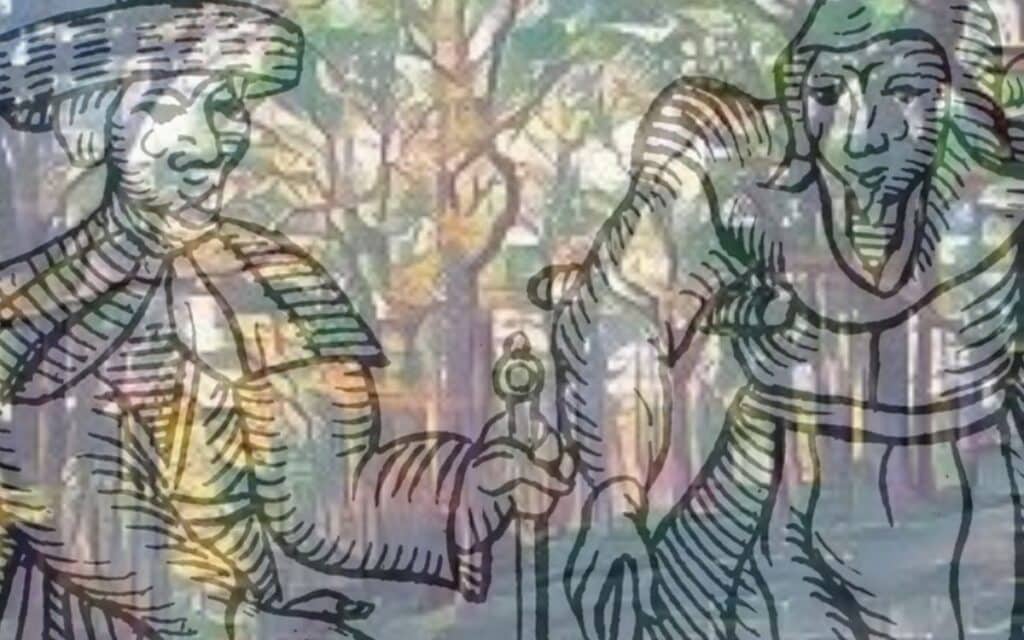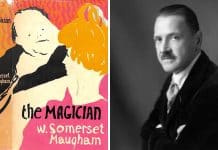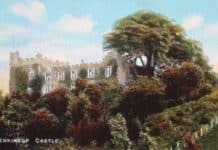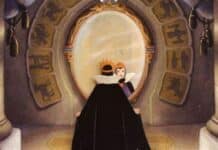The Derwent Valley of Northumberland has has a long history of witchcraft and devil worship. GAYLE FIDLER tells us about some its strangest goings-on…

“Ghosts and Witches come in for a share.
Though poor Frizzle has long breathed her last.
On broomsticks who rode through the air.
And scattered her pins as she past.”
John Carr – Derwent, An Ode.
The River Derwent traditionally formed the western border between County Durham and Northumberland. The river takes its name from the Celtic “Deerwint” or “river where oaks grow”. The Derwent Reservoir opened in 1967, is 3.5 miles long and is one of the key water supplies for the Northeast of England.
The surrounding countryside is in the North Pennines Area Of Outstanding Natural Beauty. Today it is the haunt of walkers, cyclists and birdwatchers. However, history has a darker tale to tell. Stories of witchcraft and devil worship from the small villages which scatter the landscape, are still spoken of to this day.
The Headless Bear of Hunstanworth
In 1641, one Margaret Hopper tended to a farmstead in the small village of Hunstanworth. Upon returning home to her husband, she became confused and started talking about strange things that had happened to her on the farm.
Her husband believed her to be bewitched and unsuccessfully tried to get her to recite the Lord’s Prayer. Margaret began to foam at the mouth and could not recite the ending. Her husband, concerned for his wife, sent for her sister and some other family members to help.
Upon their arrival they witnessed the bed upon which she lay, moving and shaking. Poor Margaret told her family she had been followed by a bear to the farm and that she had to beat it away.
After a couple of days, Margaret appeared to be making a recovery, until one Sunday evening. Her family were summoned to her room by her cries.
“Did you not see the Devil?” she shouted at them. This was followed by a great rumbling noise outside the house. The party rushed to the window, but there was nothing there.
Turning back to the room, they saw a strange beast, which resembled a bear but without a head or tail. The creature ran towards the bed.
Mr Hopper struck at the beast, but it grabbed Margaret from the bed and dragged her into the hall, where it kept her prisoner. The family tried to rescue poor Margaret but were held back by flames and a terrible smell which the monster projected upon them.
Margaret eventually managed to escape by praying and returned to her bedroom, where her family helped her into bed and carried on praying.
Regaining her strength, Margaret jumped out of bed and thrust her legs out of the window, as flames shot from her feet. The group continued to pray, and the creature thankfully disappeared. As it did the image of a young girl with a shining complexion appeared. The group fell to their knees before her, thanked the lord and the child vanished.
So concerned were the group about the strange occurrence, that they allowed the story to be published in a London pamphlet, giving their names and swearing the truth.
The Dark Arts of Crooked Oak
A 17th Century Farmhouse, by the name of Crooked Oak, is situated in one of the most beautiful yet notorious spots in Derwent Valley.
The farmhouse was said to be the site where witchcraft was believed to be practised in the 16th and 17th centuries. Referred to locally as “Dark Arts”.
Jane Frizzle is one of Crooked Oaks most well-known inhabitants, known locally as a witch. It was said she flew upon her broomstick at night, casting spells on men, maiden, and cattle.
Very little else is known about Jane. Legend has it that she is buried in an unmarked grave in a field near to where she lived. It is said that travellers would carry a crooked silver sixpence in their hands, when crossing the surrounding lands, to save them from an attack by witches.
Dancing with the Devil
On the 9th April 1673, one Ann Armstrong gave evidence at Morpeth of crimes of alleged witchcraft. Ann gave testimony that she had attended meetings of Witches at various locations in the Derwent Valley. Ann named those who were also in attendance and gave details about the meetings.
Ann’s evidence included, people dancing:
“In the likenesse of haires, some in the likenesse of cats and others in the likenesse of bees.”
She also stated that she had met the devil at these dances and the devil made the group confess the evil deeds they had done. Confessions included the killing of neighbours’ animals and children by bewitching them.
There is no record of any sentence passed upon the accused. However, superstition must have remained amongst the locals. The hamlet of Allensford kept an amulet to protect against witches stealing horses during the night.
The Evil Eye
St Edmund’s Church in the village of Edmundbyers has the gravestone of Elizabeth Lee, said to be the last of a long line of witches from the area who died in 1792. Very little is known about Elizabeth, other than her husband was also reported locally to be a witch.
After Elizabeth’s death the villagers became fearful that she would rise from her grave. It is said that in order to keep calm, the vicar installed a stained-glass window depicting The Eye Of God in the church, to ward off evil spirits.
The gravestone now hangs under the window. Wild garlic was planted in the churchyard and many locals planted Rowan trees in their gardens to keep evil at bay.
Tell us your thoughts about this article in the comments section below!







